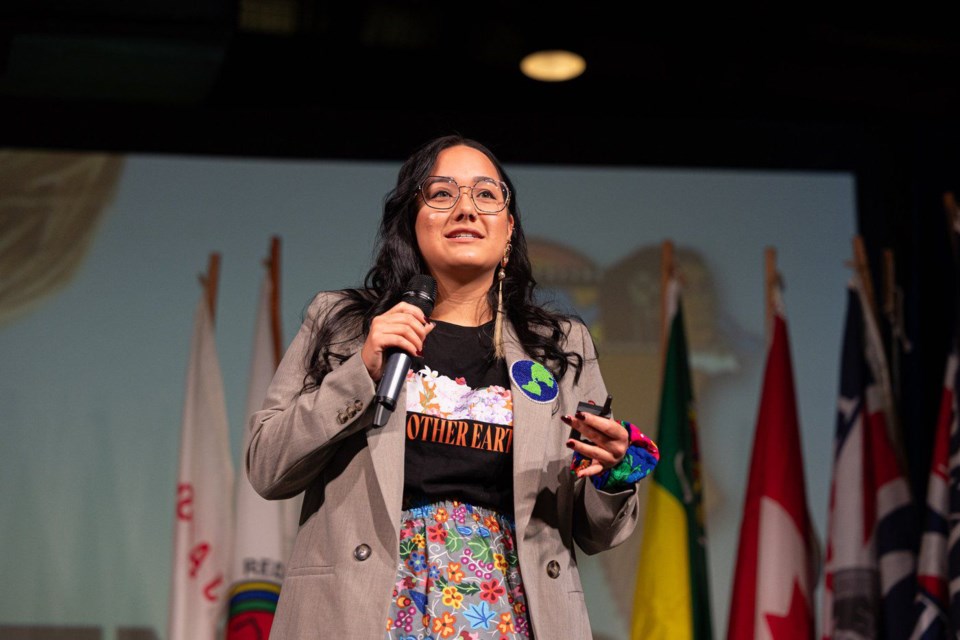SASKATOON — When Aubrey-Anne Laliberte-Pewapisconias attends a national or international conference to advocate for climate causes, she is usually the lone young Indigenous woman on a panel with men from industry or politics.
Recently, the University of Saskatchewan student from Canoe Lake Cree and Little Pine First Nation donned a ribbon skirt, feather earrings and grey blazer with a beaded pin of the earth to deliver a keynote presentation to the first organized by the Prince Albert Grand Council.
On stage, she noted her nerves and discomfort with the context: a young Indigenous woman tasked to be an all-encompassing voice for Indigenous peoples — grateful to be there, but uneasy.
“There’s a lot of work to be done to recognize Indigenous rights and our sovereignty,” Laliberte-Pewapisconias said in an interview.
“We’re not meeting Indigenous folks where they are at, and we’re leaving them out of important discussions.”
Laliberte-Pewapisconias was among Indigenous delegates who participated in last year’s COP27 conference in Egypt. She was encouraged to see Indigenous representatives from around the world, whose viewpoints and concerns were very similar to hers in Saskatchewan, she said. But their meetings were held separately and coincided with those of world leaders.
“In some spaces that I’ve seen, one (issue) is a power dynamic,” she said. “It’s a struggle to give Indigenous people everything that we’re demanding. (That) would be to give up the power, one the government has held for so long.”
A , is attending this year’s COP28 in Dubai. It includes representatives from the mining, forestry, energy, agriculture and economic development industries.
The province has said it’s working with entities that are interested in participating, including Indigenous groups, companies and economic development groups.
At the climate change conference in Saskatoon recently, PAGC Vice Chief Christopher Jobb said the PAGC has not been in conversation with the province regarding COP28 but is interested in having that discussion.
Saskatchewan’s per capita greenhouse gas (GHG) emissions are the highest in the country. In signing the 1997 Kyoto Protocol, Canada pledged to reduce emissions to six per cent below the 1990 levels by 2012. In Saskatchewan, emission levels dropped 16 per cent from a peak 77 metric tons in 2018 to 65 metric tons in 2020, but have slightly rebounded since.
Oil and gas continue to account for 25 per cent of the province’s GHG emissions, followed by electricity at 23 per cent. The latter has generated criticism from political opposition and Indigenous groups, particularly in the Delta region as hydro power generators have been affecting Cumberland House’s river system and subsequent ecosystem.
“You can’t put a price tag on climate change,” Jobb said. “It should be more diversified when it comes to climate change.
“Knowledge keepers are also stewards of the land and we need to collaborate on that, not just in Saskatchewan but right across Turtle Island.”
The PAGC’s climate change conference — “Braiding Knowledge: Clean Energy” — brought together Indigenous elders, leaders, and industry representatives.
For Laliberte-Pewapisconias, who has been active across conversations as an Indigenous youth advocate and environmentalist, including as part of the City of Saskatoon’s Indigenous technical advisory group, the solution to better-regulating industry at a rate that is mindful of the Earth’s capacity to meet its demands returns to Indigenous ways of being.
“We’re still here,” she said, “and we’re on the path to climate solutions.”
Kimiya Shokoohi is the Local Journalism Initiative reporter for the Saskatoon StarPhoenix. The LJI program is federally funded by the Government of Canada.
SASKTODAY.ca is Saskatchewan's home page. Bookmark us at this link.




